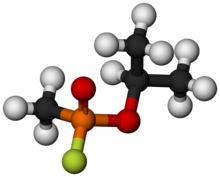
Back سارين Arabic Sarín AST Zarin AZ سارین AZB Зарын BE Зарын BE-X-OLD Зарин Bulgarian Sarin BS Sarín Catalan Sarin Czech
 | |
 | |
| Names | |
|---|---|
| Pronunciation | /ˈsɑːrɪn/ |
| Preferred IUPAC name
Propan-2-yl methylphosphonofluoridate | |
| Other names
(RS)-O-Isopropyl methylphosphonofluoridate; IMPF;
GB;[2] 2-(Fluoro-methylphosphoryl)oxypropane; Phosphonofluoridic acid, P-methyl-, 1-methylethyl ester EA-1208 TL-1618 T-144 | |
| Identifiers | |
3D model (JSmol)
|
|
| ChEBI | |
| ChEMBL | |
| ChemSpider | |
PubChem CID
|
|
| UNII | |
CompTox Dashboard (EPA)
|
|
| |
| |
| Properties | |
| C4H10FO2P | |
| Molar mass | 140.094 g·mol−1 |
| Appearance | Clear colourless liquid, brownish if impure |
| Odor | Odourless in pure form. Impure sarin can smell like mustard or burned rubber. |
| Density | 1.0887 g/cm3 (25 °C) 1.102 g/cm3 (20 °C) |
| Melting point | −56 °C (−69 °F; 217 K) |
| Boiling point | 158 °C (316 °F; 431 K) |
| Miscible | |
| log P | 0.30 |
| Hazards | |
| Occupational safety and health (OHS/OSH): | |
Main hazards
|
Extremely lethal cholinergic agent. |
| GHS labelling: | |

| |
| NFPA 704 (fire diamond) | |
Threshold limit value (TLV)
|
0.00003 mg/m3 (TWA), 0.0001 mg/m3 (STEL) |
| Lethal dose or concentration (LD, LC): | |
LD50 (median dose)
|
39 μg/kg (intravenous, rat)[3] |
| NIOSH (US health exposure limits): | |
IDLH (Immediate danger)
|
0.1 mg/m3 |
| Safety data sheet (SDS) | Lethal Nerve Agent Sarin (GB) |
Except where otherwise noted, data are given for materials in their standard state (at 25 °C [77 °F], 100 kPa).
| |
Sarin (NATO designation GB [short for G-series, "B"]) is an extremely toxic organophosphorus compound.[4] A colourless, odourless liquid, it is used as a chemical weapon due to its extreme potency as a nerve agent. Exposure can be lethal even at very low concentrations, where death can occur within one to ten minutes after direct inhalation of a lethal dose,[5][6] due to suffocation from respiratory paralysis, unless antidotes are quickly administered.[4] People who absorb a non-lethal dose and do not receive immediate medical treatment may suffer permanent neurological damage.[citation needed]
Sarin is widely considered a weapon of mass destruction. Production and stockpiling of sarin was outlawed as of April 1997 by the Chemical Weapons Convention of 1993, and it is classified as a Schedule 1 substance.
- ^ "Material Safety Data Sheet – Lethal Nerve Agent Sarin (GB)". 103d Congress, 2d Session. United States Senate. May 25, 1994. Retrieved November 6, 2004.
- ^ "Sarin". National Institute of Standards and Technology. Retrieved March 27, 2011.
- ^ "Substance Name: Sarin". ChemIDplus. U.S. National Library of Medicine, National Institutes of Health. Retrieved January 19, 2020.
- ^ a b Sarin (GB). Emergency Response Safety and Health Database. National Institute for Occupational Safety and Health. Accessed April 20, 2009.
- ^ Anderson K (September 17, 2013). A Poisonous Affair: America, Iraq, and the Gassing of Halabja review of A Poisonous Affair: America, Iraq, and the Gassing of Halabja by Joost R. Hiltermann (Cambridge UP 2007). Lawfare: Hard National Security Choices (Report). Retrieved December 30, 2015.
... death can occur within one minute of direct inhalation as the lung muscles are paralyzed.
- ^ Smith M (August 26, 2002). "Saddam to be target of Britain's 'E-bomb'". The Daily Telegraph. p. A18. Retrieved December 30, 2015.
The nerve agents sarin and VX. Colourless and tasteless, they cause death by respiratory arrest in one to 15 minutes.
